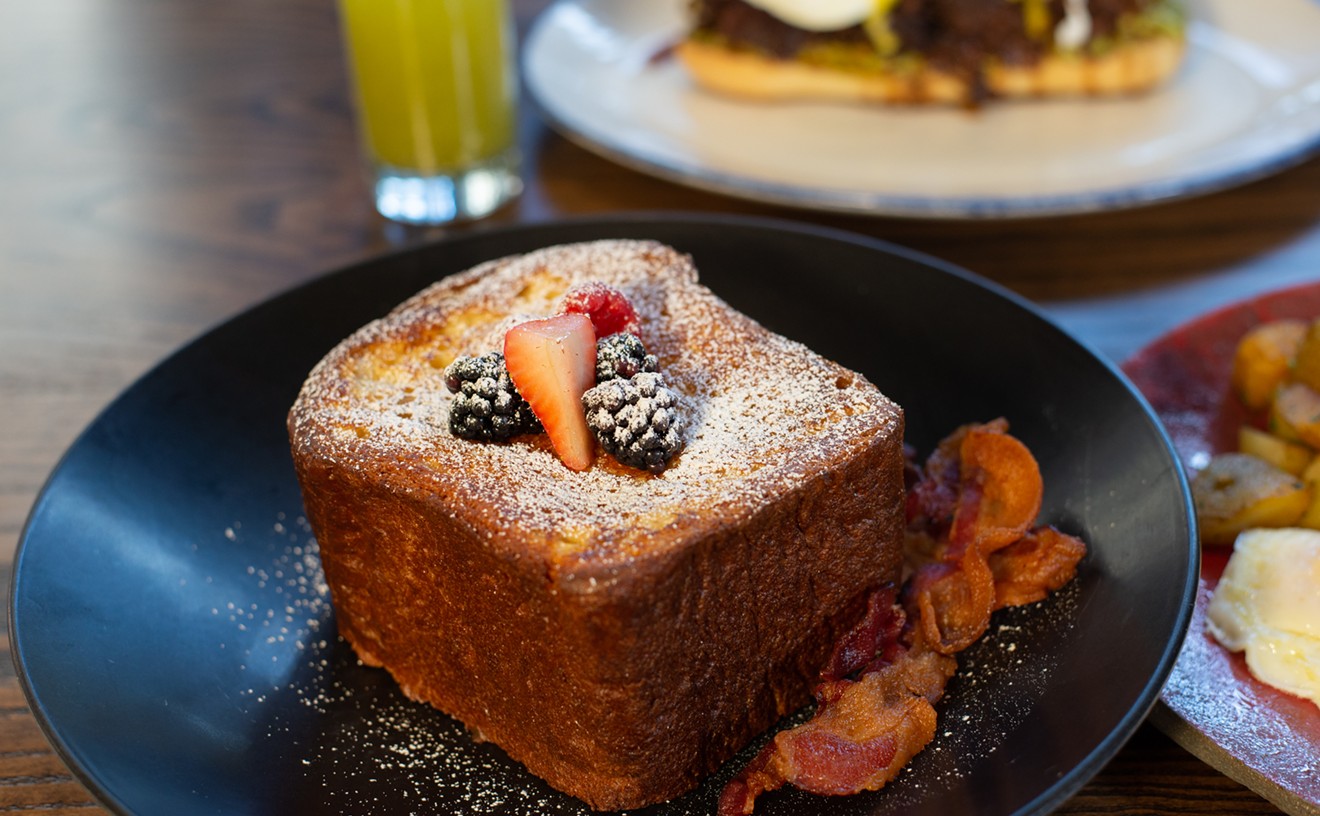Sure, it has a few leftovers like plush green screens cordoning the entrance that look as if they were put together with casket upholstery. And though my memory is faulty from years of absorbing blows to the forehead from Champagne corks, the velvety burgundy window treatments look the same as they did on a previous visit long ago.
Among the precious few things chef James Neel and his wife, Lisa, did when they took over Tramontana last fall was change one of the poster-like murals on the wall in the dark dining nook in the restaurant's recesses just off the kitchen. "It used to be lady with some long legs sitting there up on the wall smoking a cigarette," he says, explaining how this spindly-limbed woman was painted to serve as an artful smoking-section placard.
But since cigarettes are no longer the appealing cosmetic accessory they once were, Neel painted over the long-legged ash-flicker with another mural, one that was a more than fitting replacement -- a picture of a fireplace. Tramontana, named for a cold northern wind that blows across the Western Mediterranean, was opened five or so years ago by Jean-Michel Sakouhi, a Mansion refugee who also helped launch Sipango and now operates the much-lauded Le Paris Bistrot on McKinney Avenue. Tramontana slipped away from Sakouhi in a divorce and was picked up by Jade Synhorst and Gary Barnes. From there it went into the hands of Neel and his wife, who immediately began tweaking its quasi-French bistro fare, replacing it with one of the countless menus wearing the "New American" designation. Neel describes his version as a little French, a little Italian, and a little Texan.
"I felt the only thing this place was missing was a nice fireplace," says Neel, perhaps reflecting on the restaurant's name. "And I couldn't afford a real one. So I painted one on."
Brushed into this homey fireplace facsimile are a couple of duck and pear likenesses roasting in the flames. The model for part of this image turns up on the menu, though even with tasty grilled pears, the buttery walnut-cluttered salad in port-wine vinaigrette ($5.95) still suffered, seemingly from a chilly northern wind. The salad, obviously pre-assembled and tossed in a deep-chill box, was so cold that it frosted any hope of successfully meshing the flavors locked up in the apple-smoked bacon, the Roquefort cheese, the nuts, and the vinaigrette.
Fortunately, the soups were spared the same chilly fate. Tomato-dill soup ($3.95) was scalding hot and tangy but a little thin with only modest dill taste coupled with a flavor reminiscent of dishwater. Chicken- pasta soup ($3.95) was searing hot and seething with richness, flavors no doubt rendered from the shiny little polka dots of fat floating over the surface. It was a hearty slurp, despite the paucity of chicken and the mushy, overcooked pasta, which might have been orecchiette, but was hard to discern in its disintegrating state.
Which is also the condition of the mural featuring a large bottle of Chateau Margaux painted on the wall around the time of the restaurant's inception. Like the woman with the shapely, spindly limbs and the smoke, this bottle of wine will be painted over. Neel says the mural was severely damaged New Year's Eve after the guitarist from the blues band they had hired for the evening smashed the wall with the head of his guitars.
To the remaining Toulouse-Lautrec-ish murals that contain beer advertisements and cancan girls, Neel has added some framed art of Mediterranean scenes. But these are the only apparent differences from the old spot. There is still the planked wood paneling around the base of the bar, the basketball-sized lighting fixtures, and the general dusky ambience. Bottles line the back bar on shelves supported by chains anchored in the wall.
In addition to liquor bottles, these shelves hold a few of the selections from Tramontana's brief, casual, and very bistro-ish wine list. There's a good scattering of comfortable, non-confrontational California wines -- Mondavi Sauvignon Blanc, Chalk Hill Chardonnay, Clos de Bois Merlot, Jordan Cab -- with a fistful of French bottlings tossed in to make that guitar-damaged Margaux depiction feel at home. Chilean wines are served mostly by the glass.
It's easy to appreciate the efforts of Neel, a chef who most recently was in the kitchen at Al Biernat's after stints at the Brookhaven Country Club and the French Room. In fact, it's sometimes hard to differentiate Neel and his wife from the rest of the Tramontana staff, so prominent are they in the dining room, mingling with guests, personally overseeing service. At the same time, it can be difficult to appreciate the results of these efforts without a lot of squinting and twitching.
No facial expressions were necessary to nudge appreciation of the Absolut pepper diablo sauce that came with the potato-crusted calamari ($6.95). Robust and rich with chunks of barely scalded pieces of plump, hearty tomato, this house-made condiment was without question among the best tomato-based dipping sauces I've stumbled across. It was full, broadly flavored, and lively. Too bad the calamari lacked the spine to match it. Not that there was a problem with the coating, which was fine, if a little shy on herbs and spices. But the squid meat was little more than rings of spongy mush, like bits of flaccid, overcooked pasta.
This was nothing compared with the condition of the shrimp accompanying the pasta in coriander pesto with roasted corn and flecks of washed-out pancetta ($12.95). The shrimp, purportedly grilled, had the consistency of porridge -- little curls of butterflied pulp. I wondered how it was possible to cook shrimp to this consistency without the use of explosives. And this is regrettable, because the pasta was fine and the pool of rich pesto sauce, herbed with the leaves of the coriander plant (cilantro) rather than the mildly aromatic seeds, was smoothly savory and satisfying.
As was the goat-cheese-crusted chicken with tart cherry sauce ($13.95). Though the chicken was a little parched, the contrast between lively spark of the goat cheese and the cherry sauce, which was more sweet than tangy (despite a punch from a little balsamic), was alluring. A side of red-wine-braised red cabbage flourished with cinnamon and a little raspberry vinegar was engagingly wintry, while side dollops of sweet potato and roasted garlic mashed potatoes were smooth and rippling with flavor, even though they were too thin in consistency.
A grilled trio consisting of peppercorn New York strip, horseradish pork tenderloin, and goat-cheese chicken ($17.95) came off like a rash collision of disparate pieces. The sauces, a creamed peppercorn sauce floating the steak and the tart cherry sauce lathering the chicken breast, colluded and clashed. Plus, the pork and the steak were spongy and mushy (the chicken again was dry), with little show in the way of flavor highlights, even though the pork was covered with horseradish. A side of snow peas and corn was crisp, fresh, and flavorful.
But at least the core elements in this trio were hot. The caramelized salmon ($10.95, lunch) with lemongrass buerre blanc, was surrounded by sides that were cool or barely hovering above room temp, including little clumps of drying spinach and stiffening mashed potatoes. Hot in parts, the salmon was slightly overcooked and the buerre blanc had no discernable hint of lemongrass.
Temperature was also a problem with the Grand Marnier crème brûlée ($6.95). The lid was cold instead of warm, and the custard, though cool, was a little shy on flavor.
Another one of the modest evolutionary modifications Neel says he's planning for Tramontana is a four- to six-seat chef's table, which will be parked inside his kitchen. And this is where the evolutionary vigor should remain focused, to ensure the longevity of this alluringly snug neighborhood bistro.










